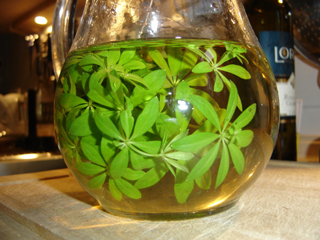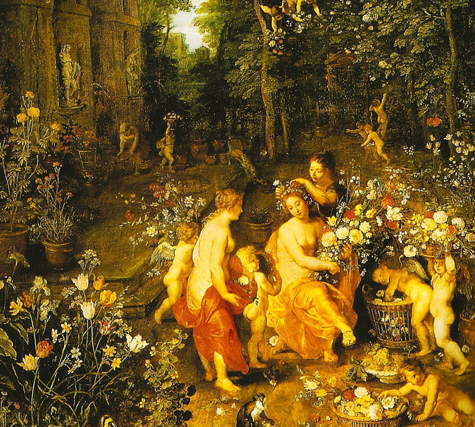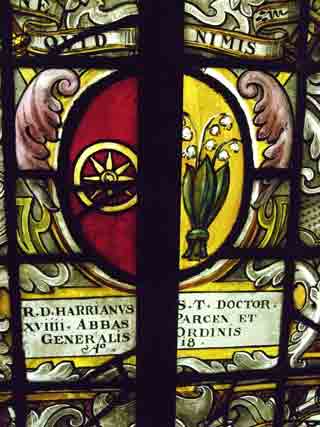Human Flower Project
May’s Lap of Lush-ery
Waverly Fitzgerald sings three Mayflowers and will strike a chord with every nymph and satyr.

Mai bowle, Germany’s spring drink, made with sweet woodruff
Photo: brauchtumsjahr
By Waverly Fitzgerald
February 14 has staked its claim on love and sexuality, but an older, far more ecologically erotic season comes now – May Day. In the Northern Hemisphere, buds are at the full. Sweaters come off and the sap is rising. For centuries May has been synonymous with flowers and all the ardor that comes with them.
In the third century, the Romans celebrated the Floralia for six days beginning on April 28. People put on their most colorful garments, decking themselves and their animals in flowers.
The first mention of May Day in England comes from around 1240 – with a note of disdain. The Bishop of Lincoln complains of priests who join the “games which they call the bringing-in of May.” Town records, literature and the accounts of courtly life refer to the custom of bringing green branches and flowers in from the woods to celebrate the beginning of summer.
Edmund Spenser writing in 1579 described the custom thus:
Youth’s folks now flocken in everywhere
To gather May baskets and smelling brere
And home they hasten the posts to dight
And all the Kirk pillars ere daylight,
With hawthorn buds and sweet eglantine,
And garlands of roses and sops in wine.

Flora in the Flower Garden
By Jan Bruegel the Elder, c. 1600
Flowers are the sexual organs of plants, so amid all that flagrant flowering, the natural impulse for humans was (is?) to celebrate with dancing, flirting and sex. The Puritan Philip Stubbs frowned on May Day’s celebration and its rampant sexuality (1583) just after Spenser had extolled it:
“I have heard it credibly reported by men of great gravity, credit and reputation,” Stubbs wrote, “that of forty, threescore or a hundred maids going to the woods over night, there have scarcely the third part of them returned home again undefiled.”
All sorts of spring blossoms figure prominently in May Day lore, as garlands, as wreaths, in baskets hung on doorknobs. But certain flowers appear most frequently.

Hawthorn in bloom, Kelston Roundhill, England
Photo: Cowboys and Custard
The hawthorn (Crataegus monogyna) is the quintessential flower of May in England. It is often called the May tree and its blossom the Mayflower, after the month when it flowers. I recognize the tree in bloom because it reminds me of a chenille bedspread, with its lumpy, blossom-laden boughs. Some find the flowers’ musky smell unpleasant, but Robert Graves writes, “Hawthorn blossom has, for many men, a strong scent of female sexuality; which is why the Turks use a flowering branch as an erotic symbol.”
 Lilies of the valley in a window dedicated to St. Norbert, for the Norbertine abbey in Parc, Louvain (now part of Belgium). Window by Jean de Caumont, 17th century, Speed Art Museum, Louisville, KY
Lilies of the valley in a window dedicated to St. Norbert, for the Norbertine abbey in Parc, Louvain (now part of Belgium). Window by Jean de Caumont, 17th century, Speed Art Museum, Louisville, KY
Photo: Human Flower Project
In France, the flower of May Day is lily of the valley (Convallaria majalis) or muguet, another fragrant flower which blooms early in the month. It is given as a token of good luck on the first of May. Custom decrees that a woman who receives a gift of lily of the valley should respond with a kiss.
In Germany, the flower of May is sweet woodruff, also known as Waldmeister, King of the Woods. It blooms around the first of May and is used as a flavoring ingredient in the Mai Bowle, the traditional summer drink of Germany, which is often served on May Day.
To make a traditional May wine, pick woodruff right before the flowers bloom. Woodruff does not have a strong fragrance until it dries, when it develops a sweet aroma, a mixture of hay and vanilla. The scent comes from coumarin, a fragrant chemical also found in melilot and tonka beans. Immerse the dried herb in a bottle of wine, usually Rhine wine (herbalist Adelma Grenier Simmons recommends champagne or a mixture of half Rhine wine and half champagne).
 “Maibowle” by Georg Muhlberg (this recipe obviously including champagne)
“Maibowle” by Georg Muhlberg (this recipe obviously including champagne)
Image: burschenschaftsgeschichte
Some recipes advise leaving the woodruff in the wine for days, even weeks. Others suggest removing it after ten or fifteen minutes, probably because coumarin is an anticoagulant and may cause headaches; however, it is probably not dangerous, unless you are pregnant or taking blood thinners. Simmons garnishes her Mai Bowle with fresh woodruff, Johnny jump-ups and violets. In Germany, the Mai Bowle is served every day during the month of May.
These three May Day plants—Sweet Woodruff, Lily of the Valley and Hawthorn — have all been used medicinally to treat the heart. In America, the native people used hawthorn berries for heart tonics and rheumatism. It has also been used effectively, particularly in Germany, for treating congestive heart failure. Lily of the Valley also has a reputation for healing heart problems. The Elizabethan herbalist Gerard recommended distilling it in wine and used this remedy to “comfort the heart.” (Note: Don’t try this at home, as this plant is toxic!) And as mentioned above, the coumarin in Sweet Woodruff is effective as a blood thinner.

Charlie Chaplin dreams of wood nymphs in Sunnyside
Image: Chaplin
All three flowers are also associated with sexuality. The Romans used the hawthorn in marriage ceremonies. Sweet woodruff has a reputation for provoking lechery. And scientists have recently learned that Bourgeonal, an aromachemical that smells like lily of the valley, “attracts male sperm.”
May at your own risk!
Editor’s note: Waverly Fitzgerald, an expert in seasonal holidays, writes about the folklore of flowers. She is currently working on My Year in Flowers: The Adventures of an Amateur Urban Naturalist about her quest to find nature in the city. She lives in Seattle, Washington.


What a fabulously written and informative post! My sister-in-law and I went walking this morning and I think the May Day flower in Montclair, NJ is the azalea! Residential and church yards are abloom in red, pink, and white.